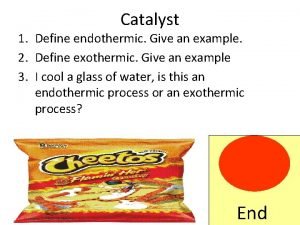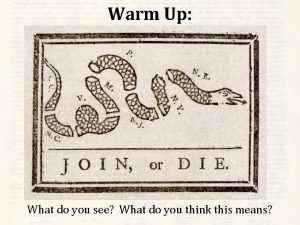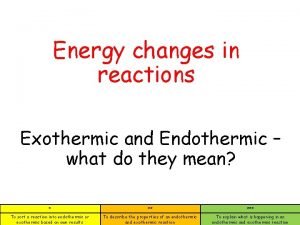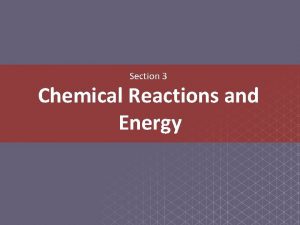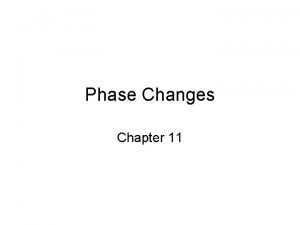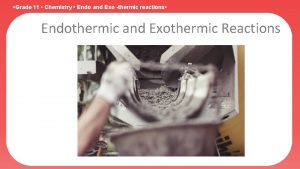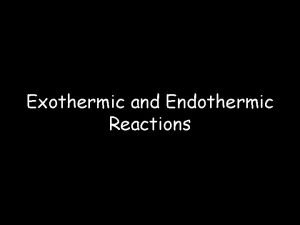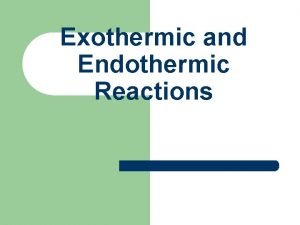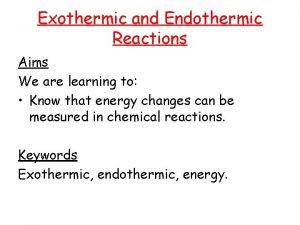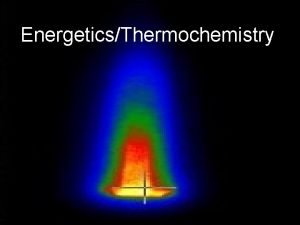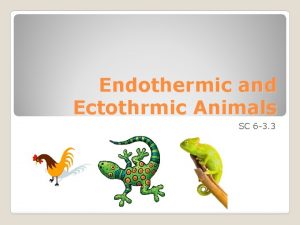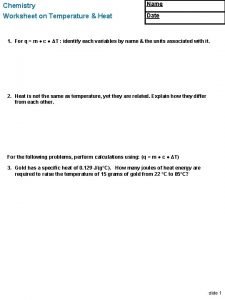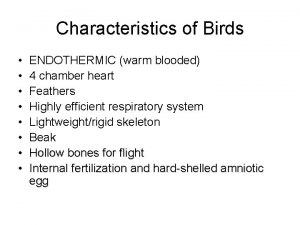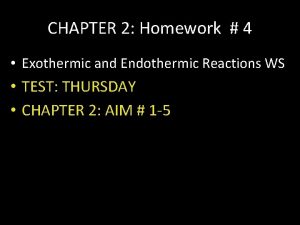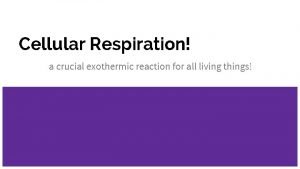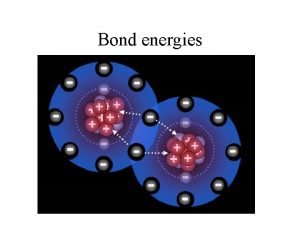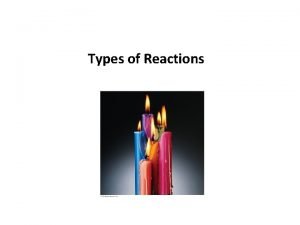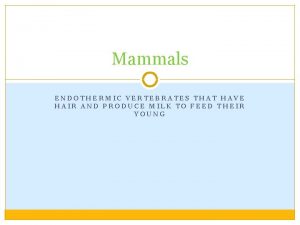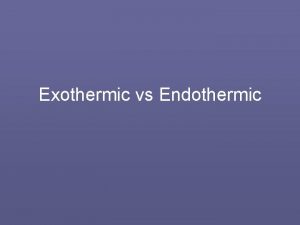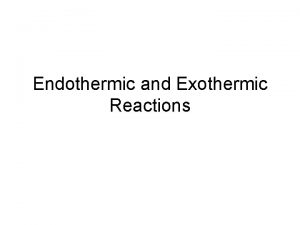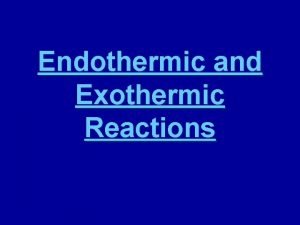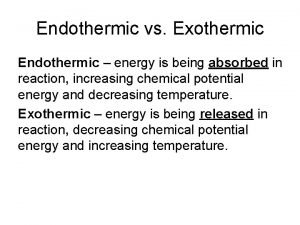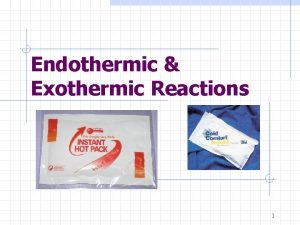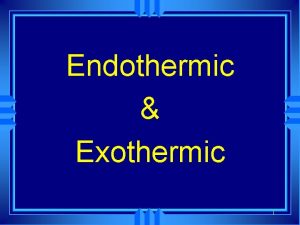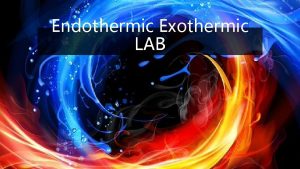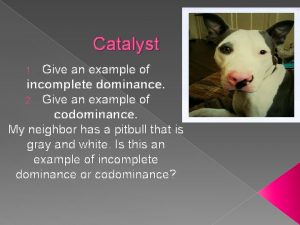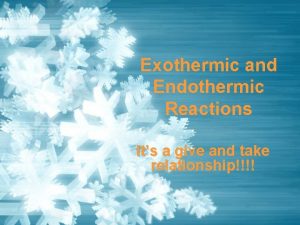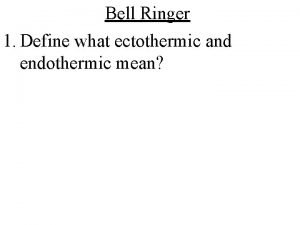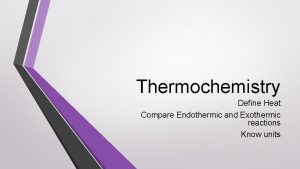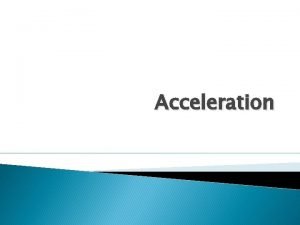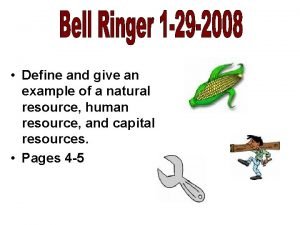Catalyst 1 Define endothermic Give an example 2






















- Slides: 22

Catalyst 1. Define endothermic. Give an example. 2. Define exothermic. Give an example 3. I cool a glass of water, is this an endothermic process or an exothermic process? End

Learning Log Assessment Rate yourself 1 – 4 on LTs 7. 1 and 7. 2


LECTURE 7. 2 – CALORIMETRY

Today’s Learning Target • LT 7. 6 – Using calorimetry data, I can utilize my knowledge of temperature change and specific heats to calculate the amount of heat transferred for a reaction.

Today’s Focus Question • How do we determine the amount of calories in Flamin’ Hot Cheetos?

How is the energy of food measured?

I. Specific Heat • The amount of energy that is transferred is dependent on the nature of the material receiving the energy. • Specific Heat (Cp) – The energy required to raise the temperature of one gram of substance one degree Celsius


II. Calorimetry • Calorimetry is the science of measuring the heat of a chemical reaction. • q represents the heat gained/released • Cp is the specific heat • ΔT = Final Temperature – Initial Temp.

Class Example • A 4. 0 g sample of glass is heated from 274 K to 314 K. Glass has a specific heat of 0. 20 J/(g x K). How much heat is gained during this heating?

Table Talk • The specific heat of copper is 0. 4 J/o. C. How much heat is needed to change the temperature of a 30 g sample of copper from 20. 0 o. C to 60. 0 o. C?

Stop and Jot • Determine the specific heat of a material if a 35 g sample absorbed 96 J as it was heated from 293 K to 313 K.

SUMMARIZE

Food Facts! How much sugar do you take in every day? Every week? Every year?

Calories in Flamin’ Cheetos • Q can be measured in calories • Food scientists measure the calories contained within food by measuring the amount of energy it takes to raise 1 g of water 1 o. C. • 1000 calories = 1 Calorie • 1 serving of Cheetos has 140 Calories

Flamin Hot Cheetos Lab

Flamin’ Hot Cheetos Lab • Read the lab carefully and answer the pre-lab questions. • This will serve as preparation for Mon/Tues lab on Flamin’ Hot Cheetos. • Grade yourself on the pre-lab assessment using the answer key available online. • Place the sticker for your corresponding score on the data wall.

Exit Slip 1. I have a sample of water and I increase the temperature from 10. 0 o. C to 40 o. C. The specific heat of water is 4. 18 J/(g x o. C). Calculate the heat absorbed for this process.

Learning Log Assessment Rate yourself 1 – 4 on LT 7. 6


Closing Time • Homework 7. 2 – Calorimetry Calculations
 Define endothermic
Define endothermic What is the main idea of give me liberty or give me death
What is the main idea of give me liberty or give me death Example of a catalyst
Example of a catalyst Poem about catalyst
Poem about catalyst Endothermic and endergonic
Endothermic and endergonic Chemical properties
Chemical properties Is vaporization endothermic or exothermic
Is vaporization endothermic or exothermic Endo exo thermic
Endo exo thermic Endothermic vs exothermic
Endothermic vs exothermic Methane oxygen endothermic or exothermic
Methane oxygen endothermic or exothermic Exothermic v endothermic
Exothermic v endothermic Is vaporization endothermic or exothermic
Is vaporization endothermic or exothermic Exo vs endothermic
Exo vs endothermic Ectotherms
Ectotherms Endothermic and exothermic worksheet
Endothermic and exothermic worksheet Endothermic characteristics
Endothermic characteristics Exothermic and endothermic homework
Exothermic and endothermic homework Cellular respiration endothermic or exothermic
Cellular respiration endothermic or exothermic Bond breaking endothermic
Bond breaking endothermic Chemical reaction examples
Chemical reaction examples Exothermic vs endothermic
Exothermic vs endothermic Endothermic potential energy diagram
Endothermic potential energy diagram Endothermic animals with hair
Endothermic animals with hair
